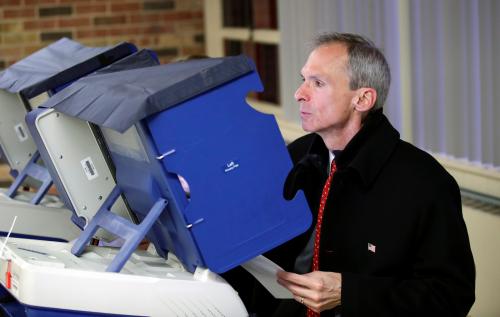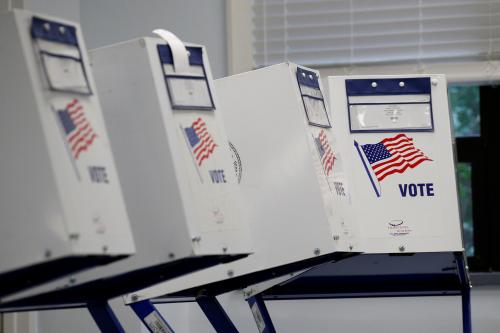Editor’s Note 1: This blog post is part of The Primaries Project series, where veteran political journalists Jill Lawrence and Walter Shapiro, along with scholars in Governance Studies, examine the congressional primaries and ask what they reveal about the future of each political party and the future of American politics.
Editor’s Note 2: In the midst of all the tumult in the Republican Party this week it would be easy to forget that Democrats are also having primaries. And so today’s FixGov post features veteran political reporter Walter Shapiro’s in depth look at a few Democratic primaries. What he finds is a political party that used to be divided over everything now appears “to have swapped their rambunctious heritage for a hefty dose of Xanax.” In the place of robust debates over privacy, inequality, the role of Wall Street money in the party and the direction of health care, Shapiro finds the Democrats focusing on bland statements of opposition to the Republicans and equally bland statements of support for Social Security and Medicare. So far at least, these primaries are providing very little information about what the post-Obama Democratic Party will look like.
For more than a century, the Democrats were the fractious political party bitterly divided over both big issues and big personalities. The battle lines went far beyond civil rights and the Dixiecrat wing of the party. Democratic donnybrooks in recent years were over everything: Vietnam; Ted Kennedy versus Jimmy Carter; the 1980s struggle between the liberals and the Democratic Leadership Council; welfare reform; Iraq; and, of course, Barack Obama versus Hillary Clinton in 2008.
These days, though, the Democrats appear to have swapped their rambunctious heritage for a hefty dose of Xanax.
Judging from some of the most significant Democratic House primaries this month, the only issue cleavages are hairline fractures. From New Jersey to California, primaries that are likely to send new Democratic representatives to Congress were decided on the basis of biography and geography.
When we embarked on the Primaries Project, we were under no illusions that the Democratic House primaries would be filled with fireworks and high drama. But I, at least, expected to find vigorous policy debates over the power of Wall Street and passionate dissents from the aggressive data collection policies of the NSA under Obama.
Wrong. For example, New Jersey’s 12th district is a solidly Democratic open seat that should be intellectual fodder for Democrats since it includes both the state capital in Trenton and Princeton. The primary there was, in essence, a three-way race among incumbent Democratic state legislators.
It was won with 43 percent of the vote by Bonnie Watson Coleman, an African-American state senator, who campaigned on the platform of standing up to the Republicans in Congress. This was not exactly controversial stuff, since no one in the Democratic primary was warbling the praises of John Boehner and Ted Cruz. Her TV ad, which aired less than a week before the primary, boldly declared, “The Tea Party wants to end Social Security and Medicare. And roll back the clock on women’s rights. Bonnie Watson Coleman will fight them every step of the way.” So the meaningful choice for voters — Democratic primary voters — was the Tea Party or Watson Coleman.
This ad was emblematic of Democrats this year: Virtually every campaign seems to be built around the defensive crouch of protecting Social Security, Medicare and abortion rights. Assemblyman Upendra Chivukula (22 percent of the vote), the first Indian-American to serve in the New Jersey legislature, ran a TV spot that captured this year’s triumph of candidate biography over substance. The memorable ad, which unfortunately has been taken down from YouTube, began, “I’m the Tea Party’s worst nightmare. I don’t look like them. I don’t sound like them.” Here we go again: The Tea Party was not Chivukula’s opponent in a Democratic primary.
The other serious candidate in the race, state senator Linda Greenstein (28 percent of the vote) was equally generic. Her TV ad (no longer on YouTube) featured a voice-over declaring, “In Congress, Linda will stand up for equal pay, affordable childcare and a woman’s right to choose.” The only glimmer of an issue difference in the entire campaign came in the closing June 1 debate when Watson Coleman attacked Greenstein for including a picture of GOP Governor Chris Christie in a 2013 campaign ad for the state senate.
After the primary, Patrick Murray, the director of the Monmouth University Polling Institute, said in an interview, “The race was almost entirely about geography and identity with only a tiny issue component that Greenstein was too close to Christie.” According to Murray, Watson Coleman won the primary going away with “an old-fashioned, shoe-leather and phone campaign that got her vote out. Her argument was, in essence, ‘You know me. You like me. You should vote for me.’
The same bland-is-better pattern emerged in Iowa’s 1st congressional district in the northeastern corner of the state. Four-term Democratic incumbent Bruce Braley (winner with 57 percent of the vote in 2012) is vacating the seat to run for the Senate. The Democrats are likely to hold the seat, especially since the five-way Democratic primary on June 3 was won by the establishment candidate, Pat Murphy, the former speaker of the Iowa house.
Murphy’s three TV spots during the primary campaign emphasized the candidate’s vanilla biography, generic Democratic issues and buzz words favored by campaign consultants:
The first ad about his family: “We made a good life out of hard work and two paychecks. In the Iowa house, I fought for families like ours.”
Everyone runs sun-dappled bio spots, but Murphy followed up with an equally anodyne commercial about how his wife had been a nurse for 33 years: “So I know that equal-pay-for-equal-work is more than a women’s issue. It’s about middle-class families.”
The final pre-primary spot was an endorsement ad built around this often-used tagline: “If you want to see what Pat Murphy will do in Congress, look at what he’s done in Iowa.”
Okay, 30-second television commercials never lend themselves to high-minded policy debates. But during the primary, Murphy’s campaign website also reflected middle-of-the-road Democratic boilerplate, emphasizing “Preserving Social Security & Medicare” and “Defending Women’s Rights.” When it comes to health care, Murphy promised to stand up “to right-wing efforts to repeal Obamacare.”
For those used to the demographic predictability of Iowa (92 percent white), the most surprising aspect of the Democratic primary in the first district was that two of the five candidates were foreign-born women.
Born in India, former state senator Swati Dandekar (18 percent of the vote) broadcast a TV ad entitled “Imagine” built around the voice-over line: “Swati’s life from a young girl to a progressive American leader is the dream we want for all our children.” And 27-year-old state representative Anesa Kajtazovic (15 percent of the vote), who came to Iowa from war-torn Bosnia, also ran heavily on her biography. Her campaign website boasted, “Only in America could a refugee rise up to graduate from college in three years with a double major and become the youngest elected woman to the state legislature at age of 24.”
Not to be left out, the other major candidate in the race, Monica Vernon (24 percent of the vote), ran on the stirring slogan, “A working mom for Iowa!” A member of the Cedar Rapids city council, Vernon ran TV commercials featuring voice-overs from her daughters saying predictable things like, “She never stops working for the middle class. We know because she’s our Mom.”
Political science professor Christopher Budzisz, who directs the Loras College Poll, was as hard-pressed as I was to find a dollop of issue content in the Democratic primary. “The race was largely devoid of substantive interplay among the candidates,” he said in an interview. “It was all biography and who can stand up better for the Democrats.”
But nothing better symbolizes the Democrats’ sudden disinterest in policy differences than a serious candidate for Congress who did not even bother to put an issues section on her website. That was the successful primary strategy adopted by Amanda Renteria in California’s largely Hispanic (72 percent) 21st district covering much of the agricultural Central Valley.
Renteria, a former Senate aide in Washington who defeated her Democratic opponent John Hernandez by a better than two-to-one margin in the primary, will oppose vulnerable first-term Republican incumbent David Valadao in November. About the closest Renteria came to issue specificity in the primary was in her TV ad (broadcast in English and Spanish) in which she promised, “In Congress, I will fight for opportunities for all of our families. That means more water, more jobs and great schools.”
And exactly who in either party is against water, jobs and great schools? Is there a political faction calling for thirst, unemployment and terrible education?
There are, to be sure, occasional Democratic House primary races around the country where the candidates are (shocking revelation ahead) staking out positions that go beyond fighting for Social Security and reproductive rights. The June 10th primary in Maine’s second district boasted a high-decibel debate between two state senators over the direction of the party. Emily Cain, who won the primary going away, was the less incendiary of the two contenders. And Ted Lieu, who was the front-running Democrat in the June 3rd primary in California’s safe-for-liberals 33rd district, actually ran a TV commercial stressing his staunch opposition to NSA “spying.”
But these races are the exception. It was Seinfeld that was billed as a sitcom about nothing. But judging from the early House primaries this year, the Democrats are coming close to matching that “Seinfeld” spirit.
The Brookings Institution is committed to quality, independence, and impact.
We are supported by a diverse array of funders. In line with our values and policies, each Brookings publication represents the sole views of its author(s).












Commentary
The Primaries Project: Are the Dems on Xanax?
June 13, 2014